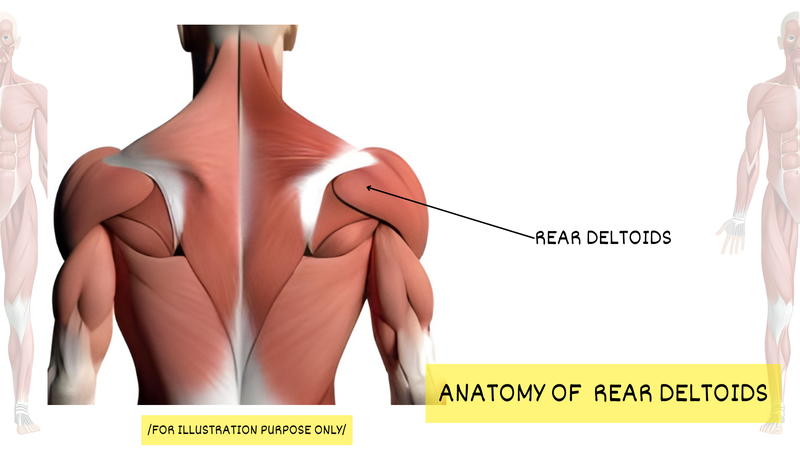6 Best Dumbbell Exercises for Sculpting Rear Deltoids
The rear deltoids, or posterior deltoids, play a significant role in shoulder stability and overall upper body strength.
Often overshadowed by the more prominent front and side deltoids, the rear delts are essential for maintaining balanced shoulder development and preventing injuries.
Engaging these muscles not only enhances your physique but also improves your performance in various sports and daily activities.
Understanding the importance of rear deltoid training can lead to better posture, increased mobility, and a more well-rounded shoulder workout routine.
In this article, we’ll explore effective dumbbell exercises specifically designed to target and strengthen the rear deltoids, helping you achieve a stronger and more defined upper body.
Best Rear deltoid exercises with dumbbell
To effectively target the rear deltoids, incorporating a variety of movements that emphasize pulling and lifting is crucial.
Focus on maintaining proper form to guarantee that the rear delts are engaged throughout the exercise.
Utilizing a controlled tempo will enhance muscle activation, allowing for a greater range of motion and improved strength development.
Additionally, incorporating different angles and positions can help to stimulate the muscles more thoroughly, assuring balanced growth and preventing overuse injuries.
Consistency in your routine, paired with adequate rest and recovery, will yield the best results for developing your rear deltoids.
Dumbbell Reverse Fly
The Dumbbell Reverse Fly is an excellent exercise for targeting the rear deltoids, helping to build strength and definition in the upper back and shoulders.
This movement not only enhances shoulder stability but also improves posture by counteracting the effects of sitting and forward-leaning activities.
By incorporating the reverse fly into your workout routine, you can develop a well-rounded shoulder musculature, which is essential for overall upper body strength and functionality.
To execute the Dumbbell Reverse Fly correctly, follow these steps:
- Begin by standing with your feet shoulder-width apart, holding a dumbbell in each hand.
- Bend your knees slightly and hinge at the hips, lowering your torso until it’s nearly parallel to the ground, while keeping your back straight.
- Allow the dumbbells to hang directly below you, palms facing each other.
- With a slight bend in your elbows, raise the dumbbells out to the side until they’re level with your shoulders.
- Squeeze your shoulder blades together at the top of the movement, then slowly lower the weights back to the starting position.
Dumbbell Rear Delt Row
The Dumbbell Rear Delt Row is an effective exercise specifically targeting the rear deltoids, which play a vital role in shoulder stability and overall upper body strength.
This exercise not only helps to develop the rear deltoid muscles but also engages the upper back, improving posture and reducing the risk of shoulder injuries.
Incorporating this movement into your training routine can enhance your shoulder aesthetics, giving you a well-rounded look by balancing out the front and side deltoids.
To execute the Dumbbell Rear Delt Row correctly, follow these steps:
- Start by standing with your feet shoulder-width apart and a dumbbell in each hand.
- Hinge forward at the hips while keeping your back straight and core engaged, allowing the dumbbells to hang down at arm’s length.
- With a slight bend in your elbows, pull the dumbbells towards your chest while squeezing your shoulder blades together.
- Hold the top position for a moment, then slowly lower the dumbbells back to the starting position.
Dumbbell Face Pull
The Dumbbell Face Pull is an effective exercise for targeting the rear deltoids, as well as the upper back and rotator cuff muscles. This exercise helps enhance shoulder stability, improve posture, and develop the overall aesthetic of the shoulders.
By incorporating dumbbells, you can engage stabilizing muscles more effectively than with traditional cable face pulls, making it a great addition to any shoulder workout routine.
Execution:
- Start by standing upright with a dumbbell in each hand, arms extended in front of you at shoulder height.
- With your palms facing each other, pull the dumbbells towards your face by bending your elbows and retracting your shoulder blades.
- Keep your elbows high and maintain a neutral spine throughout the movement.
- Squeeze your rear deltoids and upper back at the peak of the motion, then slowly return to the starting position while controlling the weights.
Dumbbell Incline Reverse Fly
The Dumbbell Incline Reverse Fly is an excellent exercise for targeting the rear deltoids, helping to build strength and enhance muscle definition in this often neglected area.
This exercise not only focuses on the rear deltoids but also engages the upper back muscles, promoting better posture and stability. By performing this exercise on an incline, you can isolate the rear deltoids more effectively, minimizing the involvement of the front deltoids and maximizing the activation of the muscles you want to develop.
To execute the Dumbbell Incline Reverse Fly, follow these steps:
- Set an adjustable bench to a 30-45 degree incline and lie face down on it, ensuring your chest is supported.
- Hold a dumbbell in each hand, allowing your arms to hang straight down from your shoulders.
- With a slight bend in your elbows, raise the dumbbells out to the sides until your arms are parallel to the floor, squeezing your shoulder blades together at the top of the movement.
- Slowly lower the dumbbells back to the starting position, maintaining control throughout the exercise.
Dumbbell Prone Reverse Fly
The Dumbbell Prone Reverse Fly is an excellent exercise for targeting the rear deltoids, which are essential for shoulder stability and overall upper body strength.
This exercise also engages the upper back, helping to improve posture and reduce the risk of injuries related to shoulder imbalances.
By incorporating this movement into your routine, you can enhance the definition of your shoulders while promoting balanced muscle development.
Execution of the Dumbbell Prone Reverse Fly:
- Begin by lying face down on a flat bench or an exercise ball, ensuring your chest is supported and your feet are firmly planted on the ground or resting against the bench for stability.
- Hold a dumbbell in each hand with your arms extended straight down towards the floor, palms facing each other.
- With a slight bend in your elbows, lift the dumbbells out to the sides, squeezing your shoulder blades together as you raise your arms until they’re parallel to the ground.
- Pause for a moment at the top of the movement, then slowly lower the dumbbells back to the starting position, maintaining control throughout the range of motion.
Anatomy of the Rear deltoid muscle
The rear deltoid muscle, also known as the posterior deltoid, is one of the three heads of the deltoid muscle located at the shoulder. It plays a significant role in shoulder extension, external rotation, and horizontal abduction, contributing to the overall stability and mobility of the shoulder joint. Understanding its anatomy is essential for targeting this muscle effectively during workouts.
Anatomically, the rear deltoid originates from the spine of the scapula and the lateral third of the clavicle, inserting into the deltoid tuberosity of the humerus. This positioning allows it to work synergistically with other muscles, such as the rotator cuff and upper back muscles, to facilitate various arm movements.
Strengthening the rear deltoid is important for achieving balanced shoulder development and preventing injuries.
Benefits of dumbbell Rear deltoid exercises
Dumbbell exercises for the rear deltoids offer numerous benefits that enhance overall shoulder strength and stability. By engaging the smaller muscles in the shoulders, these exercises promote better posture and reduce the risk of shoulder injuries, particularly for individuals who spend long hours sitting or working at a desk.
Additionally, the unilateral nature of dumbbell training helps identify and correct any strength imbalances between the left and right shoulders, ensuring balanced muscle development.
Furthermore, incorporating dumbbell rear deltoid exercises into your routine enhances overall coordination and functional strength. As these movements require greater stabilization, they engage more muscle fibers, leading to improved joint stability and balance.
This increased coordination and strength not only benefits shoulder health but also translates to better performance in various athletic and daily activities.
Important training variables to consider
When incorporating rear deltoid exercises into your routine, it’s important to evaluate training variables like volume, intensity, and rest periods to maximize results and prevent injury. Understanding these variables helps you tailor your workout for ideal muscle engagement and growth.
Volume: This refers to the total amount of weight lifted over time. Aim for 3-4 sets of 8-12 reps per exercise to effectively target your rear deltoids.
Intensity: Find a weight that challenges you while maintaining proper form. If you can easily complete more than 12 reps, it may be time to increase the weight.
Rest Periods: Allowing adequate recovery between sets is essential. Rest for 30-60 seconds between sets to maintain intensity and prevent fatigue.
Sample Rear deltoid workout with dumbbell
To effectively target the rear deltoids using dumbbells, it’s important to incorporate a variety of exercises that emphasize this muscle group. A well-rounded workout can help improve shoulder stability and posture, as well as enhance overall upper body strength. Below is a sample workout program that includes exercises specifically designed for the rear deltoids, ensuring a thorough approach to building strength and definition.
| Exercise | Sets | Reps | Rest |
|---|---|---|---|
| Dumbbell Rear Delt Fly | 3 | 10-12 | 60s |
| Bent-Over Dumbbell Reverse Fly | 3 | 10-12 | 60s |
| Face Pull with Dumbbells | 3 | 12-15 | 60s |
| Dumbbell Shrug for Rear Delt Engagement | 3 | 10-12 | 60s |
Make sure to maintain proper form throughout each exercise to maximize effectiveness and minimize the risk of injury.
Questions
How Often Should I Train My Rear Deltoids Each Week?
You should train your rear deltoids about twice a week. This frequency allows for adequate recovery while still promoting muscle growth. Just make sure to incorporate a variety of exercises for balanced development.
Can I Use Resistance Bands Instead of Dumbbells?
Yes, you can definitely use resistance bands instead of dumbbells. They offer great versatility and can effectively target your muscles. Just make sure to adjust the resistance to match your strength level for ideal results.
What Are Signs of Overtraining the Rear Deltoids?
If you’re overtraining your rear deltoids, you might notice persistent soreness, decreased strength, fatigue, and reduced range of motion. Pay attention to these signs and consider adjusting your workout routine to prevent injury.
Should I Warm up Before Rear Deltoid Exercises?
Absolutely, you should warm up before any workout, including rear deltoid exercises. Warming up increases blood flow to your muscles, reduces injury risk, and prepares your body for more intense movements. Don’t skip it!
Are There Any Specific Diets to Support Rear Deltoid Growth?
To support rear deltoid growth, focus on a balanced diet rich in protein, healthy fats, and complex carbs. Incorporate lean meats, nuts, and whole grains, and don’t forget to stay hydrated for ideal muscle recovery.
Conclusion
Incorporating these seven dumbbell exercises into your routine will help you sculpt your rear deltoids effectively.
By targeting these muscles, you’ll not only enhance your upper body strength but also improve your posture and shoulder stability.
Remember to focus on controlled movements and proper form for the best results.
With consistency and dedication, you’ll see noticeable improvements in your shoulder aesthetics and overall fitness.
So grab those dumbbells and get started on your journey to stronger, sculpted shoulders!








